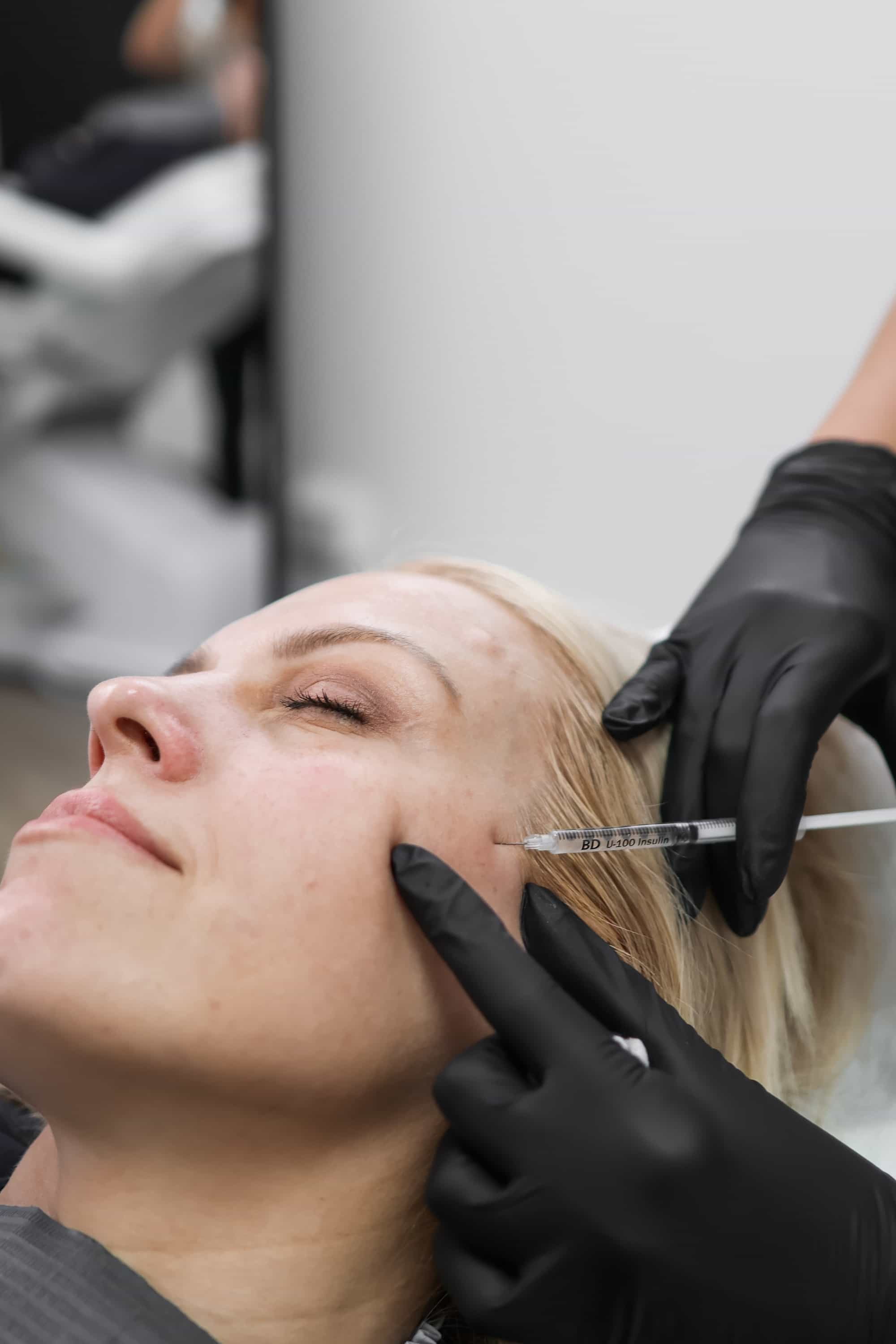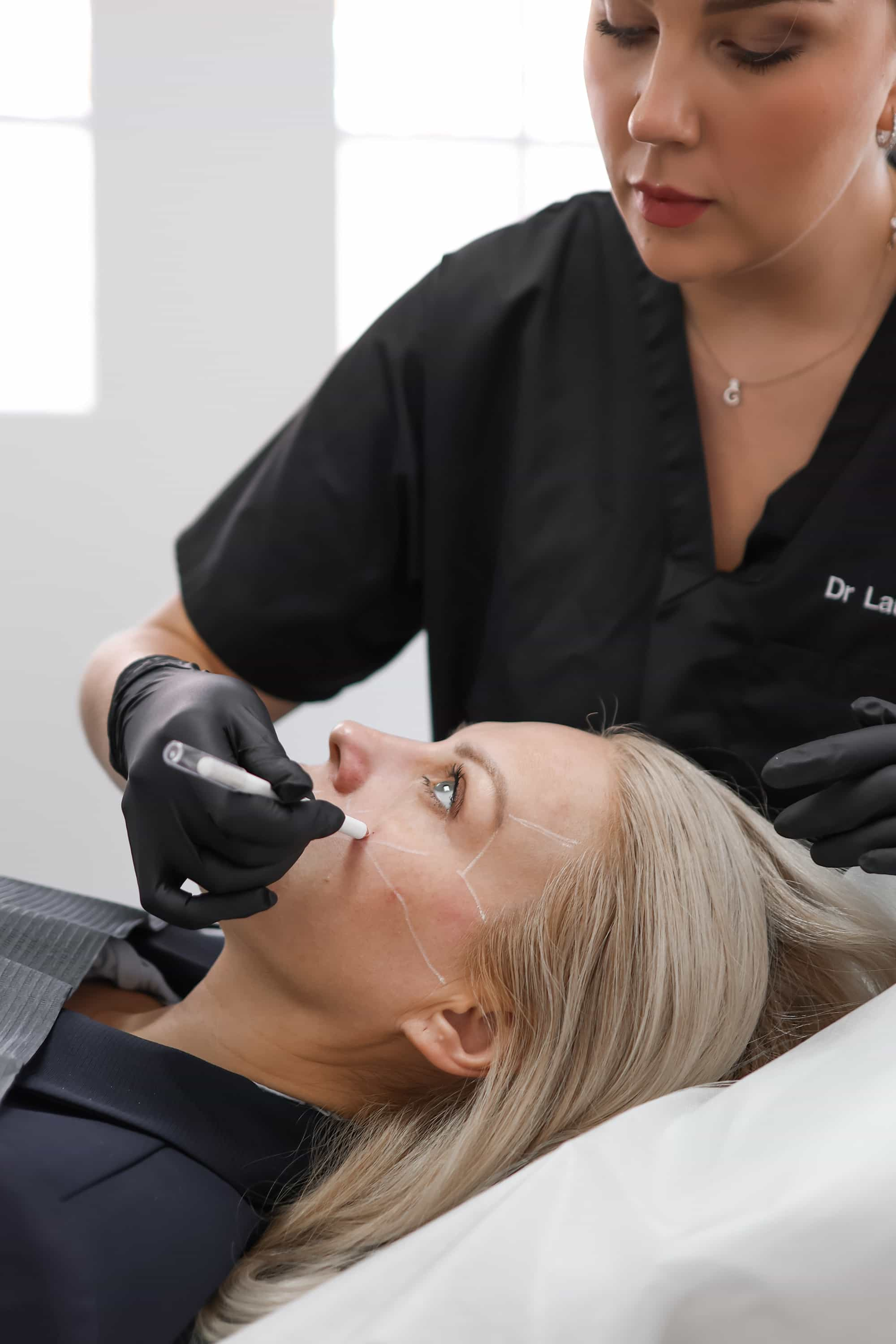Risks Associated with Sculptra Collagen Therapy
Sculptra collagen therapy, while generally safe, does come with potential risks and side effects that should be carefully considered before undergoing the procedure. These risks can range from mild and temporary to more serious and long-lasting.

Injection Site Reactions
One of the most common risks associated with Sculptra is injection site reactions. These reactions can manifest as redness, swelling, pain, bruising, or itching at the injection sites. Most often, these reactions are mild and subside within a few days to weeks. However, in some cases, they can be more severe and persistent.
Other potential risks include lumps or bumps at the injection site, which may resolve over time with massage or further treatment. Rarely, Sculptra injections can cause allergic reactions or skin discoloration. It’s important to discuss your medical history and any allergies you have with your doctor before undergoing Sculptra therapy.
As with any medical procedure, it is essential to choose a qualified and experienced provider who will thoroughly assess your individual needs and explain the risks and benefits of Sculptra therapy before treatment.
Lumps and Nodules
Sculptra collagen therapy aims to restore volume and fullness by stimulating collagen production. While generally considered safe, potential risks exist that patients should be aware of.
Some common side effects include:
- Redness
- Swelling
- Pain
- Bruising
- Itching
These reactions typically subside within a few days to weeks. More concerning risks include lumps or nodules at the injection site. These can sometimes persist and may require additional treatment.
Redness, Swelling, and Bruising
Sculptra collagen therapy, while generally safe, does come with potential risks and side effects that should be carefully considered before undergoing the procedure.
- Injection site reactions are one of the most common risks associated with Sculptra. These reactions can manifest as redness, swelling, pain, bruising, or itching at the injection sites.
- While most often mild and temporary, these reactions can be more severe and persistent in some cases.
- Lumps or bumps at the injection site are another potential risk, which may resolve over time with massage or further treatment.
- Rarely, Sculptra injections can cause allergic reactions or skin discoloration.
It is essential to choose a qualified and experienced provider who will thoroughly assess your individual needs and explain the risks and benefits of Sculptra therapy before treatment.
Allergic Reactions
Sculptra collagen therapy, while generally safe, does come with potential risks and side effects that should be carefully considered before undergoing the procedure. These risks can range from mild and temporary to more serious and long-lasting.
- Injection site reactions are one of the most common risks associated with Sculptra.
- These reactions can manifest as redness, swelling, pain, bruising, or itching at the injection sites.
- Most often, these reactions are mild and subside within a few days to weeks.
- However, in some cases, they can be more severe and persistent.
- Lumps or bumps at the injection site are another potential risk, which may resolve over time with massage or further treatment.
- Rarely, Sculptra injections can cause allergic reactions or skin discoloration.
It is essential to choose a qualified and experienced provider who will thoroughly assess your individual needs and explain the risks and benefits of Sculptra therapy before treatment.
Asymmetry and Uneven Results
Asymmetry and uneven results are potential risks associated with Sculptra collagen therapy. This can occur due to various factors, including variations in skin texture, fat distribution, or the skill of the injector.
To minimize the risk of asymmetry, it is crucial to choose an experienced and qualified injector who has a thorough understanding of facial anatomy and sculpting techniques. They should carefully assess your individual features and create a customized treatment plan to ensure balanced results.
During the procedure, meticulous injection techniques are essential to distribute the Sculptra evenly throughout the target areas. It is also important to follow post-treatment instructions carefully, such as avoiding certain activities or facial expressions that could potentially disrupt the distribution of the filler.
While Sculptra can effectively restore volume and fullness, achieving perfectly symmetrical results is not always guaranteed. Regular touch-up treatments may be required to maintain balance and address any minor asymmetries over time.
Infection
One serious risk associated with Sculptra collagen therapy is infection. As with any procedure involving injections, there’s a possibility of bacteria entering the body through the needle puncture sites. This can lead to localized or systemic infections, which may require antibiotic treatment.
To minimize the risk of infection, it’s crucial to choose a clinic that adheres to strict sterilization protocols. Make sure your injector uses sterile needles and equipment for each patient. It’s also important to follow post-procedure instructions carefully, such as keeping the injection sites clean and dry and avoiding touching or rubbing them.
Vascular Occlusion
Vascular occlusion is a rare but serious risk associated with Sculptra collagen therapy. It occurs when blood vessels are blocked by the injected substance, which can lead to tissue damage and necrosis (tissue death).
This risk is particularly concerning because Sculptra is injected into deeper layers of skin and subcutaneous tissues.
To minimize the risk of vascular occlusion, it’s essential to choose an experienced and qualified injector who understands the anatomy of the face and has extensive training in injecting Sculptra safely.
They should carefully avoid injecting near major blood vessels and monitor patients closely for any signs of vascular complications during and after the procedure.
Scarring
Sculptra collagen therapy, while generally safe, does come with potential risks and side effects that should be carefully considered before undergoing the procedure. These risks can range from mild and temporary to more serious and long-lasting.
One of the most common risks associated with Sculptra is injection site reactions. These reactions can manifest as redness, swelling, pain, bruising, or itching at the injection sites. Most often, these reactions are mild and subside within a few days to weeks. However, in some cases, they can be more severe and persistent.
Other potential risks include lumps or bumps at the injection site, which may resolve over time with massage or further treatment. Rarely, Sculptra injections can cause allergic reactions or skin discoloration. It’s important to discuss your medical history and any allergies you have with your doctor before undergoing Sculptra therapy.
Asymmetry and uneven results are potential risks associated with Sculptra collagen therapy. This can occur due to various factors, including variations in skin texture, fat distribution, or the skill of the injector.
To minimize the risk of asymmetry, it is crucial to choose an experienced and qualified injector who has a thorough understanding of facial anatomy and sculpting techniques. They should carefully assess your individual features and create a customized treatment plan to ensure balanced results.
During the procedure, meticulous injection techniques are essential to distribute the Sculptra evenly throughout the target areas. It is also important to follow post-treatment instructions carefully, such as avoiding certain activities or facial expressions that could potentially disrupt the distribution of the filler.
While Sculptra can effectively restore volume and fullness, achieving perfectly symmetrical results is not always guaranteed. Regular touch-up treatments may be required to maintain balance and address any minor asymmetries over time.
One serious risk associated with Sculptra collagen therapy is infection. As with any procedure involving injections, there’s a possibility of bacteria entering the body through the needle puncture sites. This can lead to localized or systemic infections, which may require antibiotic treatment.
To minimize the risk of infection, it’s crucial to choose a clinic that adheres to strict sterilization protocols. Make sure your injector uses sterile needles and equipment for each patient. It’s also important to follow post-procedure instructions carefully, such as keeping the injection sites clean and dry and avoiding touching or rubbing them.
Vascular occlusion is a rare but serious risk associated with Sculptra collagen therapy. It occurs when blood vessels are blocked by the injected substance, which can lead to tissue damage and necrosis (tissue death).
This risk is particularly concerning because Sculptra is injected into deeper layers of skin and subcutaneous tissues.
To minimize the risk of vascular occlusion, it’s essential to choose an experienced and qualified injector who understands the anatomy of the face and has extensive training in injecting Sculptra safely.
They should carefully avoid injecting near major blood vessels and monitor patients closely for any signs of vascular complications during and after the procedure.
Long-Term Risks
Long-term risks associated with Sculptra collagen therapy are a crucial consideration for anyone considering this treatment. While generally safe, some potential complications may emerge weeks or months after the initial procedure.
Pigmentation Changes
One long-term risk is persistent redness or discoloration at the injection sites. This can occur if the Sculptra product triggers an ongoing inflammatory response in the skin. It’s important to discuss any lingering skin changes with your injector, as they may recommend additional treatments or therapies to address the issue.
Another potential long-term risk is the formation of hard lumps or nodules at the injection site. While some lumps may resolve on their own over time, others might require further treatment, such as massage, steroid injections, or surgical removal.
It’s important to note that Sculptra stimulates collagen production, and this process can take several months to fully develop. The final results of Sculptra therapy may not be visible for several weeks or months after the initial treatment. Therefore, patience is crucial during the healing process.

Tissue Necrosis
Long-term risks associated with Sculptra collagen therapy are a crucial consideration for anyone considering this treatment. While generally safe, some potential complications may emerge weeks or months after the initial procedure.
One long-term risk is persistent redness or discoloration at the injection sites. This can occur if the Sculptra product triggers an ongoing inflammatory response in the skin. It’s important to discuss any lingering skin changes with your injector, as they may recommend additional treatments or therapies to address the issue.
Another potential long-term risk is the formation of hard lumps or nodules at the injection site. While some lumps may resolve on their own over time, others might require further treatment, such as massage, steroid injections, or surgical removal.
It’s also important to be aware that Sculptra can cause tissue necrosis in rare cases. This occurs when blood supply to the treated area is compromised, leading to cell death and tissue damage.
Early detection of vascular occlusion is crucial to prevent irreversible tissue damage. Signs to watch for include pain, swelling, redness, and discoloration around the injection site.
Implant Migration or Rejection
Long-term risks associated with Sculptra collagen therapy are a crucial consideration for anyone considering this treatment. While generally safe, some potential complications may emerge weeks or months after the initial procedure.
- Persistent Redness or Discoloration: One long-term risk is persistent redness or discoloration at the injection sites. This can occur if the Sculptra product triggers an ongoing inflammatory response in the skin. It’s important to discuss any lingering skin changes with your injector, as they may recommend additional treatments or therapies to address the issue.
- Lumps or Nodules: Another potential long-term risk is the formation of hard lumps or nodules at the injection site. While some lumps may resolve on their own over time, others might require further treatment, such as massage, steroid injections, or surgical removal.
- Tissue Necrosis: In rare cases, Sculptra can cause tissue necrosis. This occurs when blood supply to the treated area is compromised, leading to cell death and tissue damage. Early detection of vascular occlusion is crucial to prevent irreversible tissue damage. Signs to watch for include pain, swelling, redness, and discoloration around the injection site.
It’s also important to note that Sculptra stimulates collagen production, and this process can take several months to fully develop. The final results of Sculptra therapy may not be visible for several weeks or months after the initial treatment. Therefore, patience is crucial during the healing process.
Learn about the long-lasting effects of Sculptra with Dr. Laura Geige at It’s Me & You Clinic.
- How Long To See Tear Trough Filler Results - August 15, 2025
- How Long Does Radiesse Take To Build Collagen? - August 12, 2025
- How Long Does It Take For Nasolabial Fillers To Settle? - August 11, 2025
